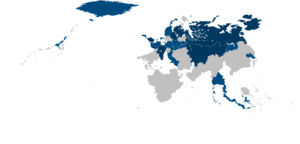Assembly of Nations
Assembly of Nations | |
|---|---|
 Map showing the members states of the Assembly of Nations | |
| Headquarters | Köpenick, Königsreh (international territory) |
| Official languages | |
| Type | Intergovernmental organization |
| Membership | 20 member states |
| Leaders | |
| Joséphine Gilson-Longchambon (Sarrac) | |
| X (X) | |
| Thorsten Reiner (Mascylla) | |
| Markus Saarinen (Valtriva) | |
| Establishment | |
• Treaty of Lehpold signed | 10 March 1917 |
• AN Charter ratified | 1 December 1917 |
• First AN Assembly meeting | 1 January 1920 |
Website www.an.org www.an.int | |
The Assembly of Nations (AN or sometimes AoN or AON) is an intergovernmental organization established to provide and maintain international peace and security, developing close relations among member states, achieving widespread international co-operation, and being a forum for the diplomatic interaction between nations as defined by its Charter instrument. It was founded after the Great War during the Treaty of Lehpold in March 1917, with its aim of preventing any future wars on the scale of the Great War, and evolved into an organization dealing with maintaining international peace and security, protecting human rights, providing humanitarian aid, promoting sustainable development, and upholding international law. Its headquarters, with all AN territories as subjects to a status of extraterritoriality, is in Köpenick, Königsreh, and it has other main offices in Lilienburg City, X.
The organization is divided into five principal organs: the AN Security Council (ANSC) as the executive organ tasked with enforcing AN Resolutions and intiating peacekeeping missions, the AN Assembly (ANA) of the organization's member states as its legislative organ, the AN Secretariat (ANSE) with the head administrative office of AN Secretary-General, the judicial International Courts of Justice, and the AN General Socio-Economic Council (ANGSEC) for interregional economic and socio-demographic matters.
The AN is the largest, most familiar, most internationally represented and most powerful intergovernmental organization in the world. Its specialised agencies include the UPESCH, ICHEF, the International Bank, the International Health Committee, and the International Food Programme. At its founding, the AN had 13 member states. As of 2020, there are now 23, all mutually recognized countries.
History
Aftermath of the Great War
Role in the Melasian Crisis
Great Game
Contemporary period
Structure
AN Security Council
The permanent members of the Assembly of Nations Security Council are the six states which are given a permanent seat in the Security Council by the Treaty of Lehpold of 1917 and further additional permissions by the AN Assembly throughout its history. These states are: the Fallish Federation, the Kingdom of Cuthland-Waldrich (formerly the Cuthish State), Federation of Central Pamiran Republics, the Kingdom of Lavaria, the Crowned Republic of Mascylla (formerly the Mascyllary Kingdom), and the Federation of Valimia. Falland, Lavaria, and Mascylla were the principal members and allies of the Armala Coalition in the Great War, as well as its victors. The other three were granted permanent seats as part of the 1943 Habernau General Conference diplomatically negotiating the political outcomes of the Melasian Crisis.
Decisions are made upon the plurality vote of the six members, in which for a binding decision two-thirds must approve; a power of veto does not exist. The Security Council is added by seven non-permanent member states rotating every two years from all member states of the AN Assembly. While they have no initiative in proposing or recommending specific ANSC action, they have the possibility to vote in ANSC decisions with a vote half as significant as those of the permanent members. The uneven number of the ANSC members theoretically allows for every decision to pass without a draw.
| Country | Current state representation | Former state representation | Current executive leaders | Current representative |
|---|---|---|---|---|
| Kingdom of Falland (1917-1923) | President: Nicholas Harper President: Matthew Anderson |
Rachel Graham | ||
| Monarch: Edwin IV Foresitters: Clifford Goodwin and Ale Dykstra |
— | |||
| — | — | — | ||
| — | King: Alberto Salazar I Prime Minister: Adriano Mafra de Chagas |
— | ||
| Queen: Dorothea I Prime Minister: Thomas Falkner |
Leonard Hennig | |||
| — | President: Seppo Toivalo Prime Minister: Katariina Järvenpää |
— |
AN Assembly
AN Secretariat
International Courts of Justice
Membership
Member states
| Flag | Country | Date of admission | Further role in the AN |
|---|---|---|---|
| Falland | X | ||
| Cuthland-Waldrich | X | ||
| Dulebia | X | ||
| Erytheria | X | ||
| Kodesh | X | ||
| Lavaria | X | ||
| Lilienburg | 10 March 1917 | ||
| Mascylla | 10 March 1917 | ||
| Ochoccola | X | ||
| Temaria | X | ||
| Valimia | X |


